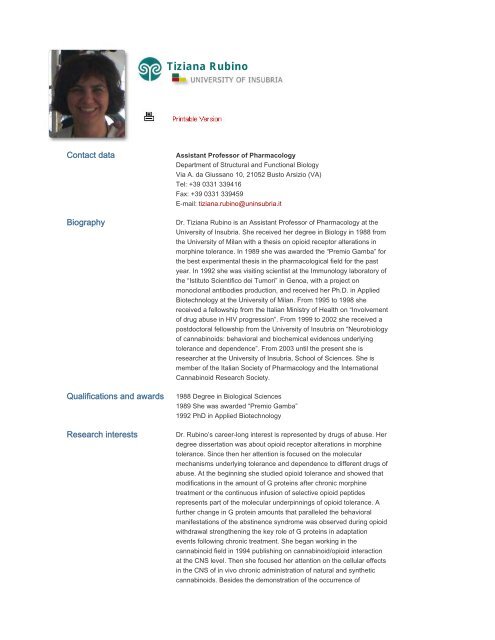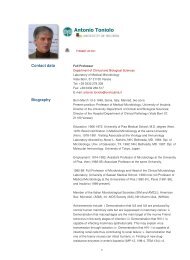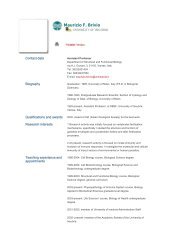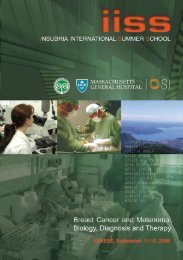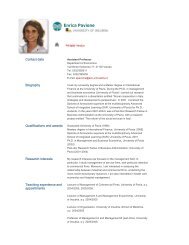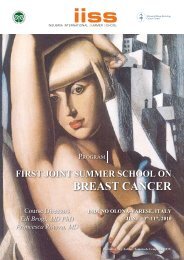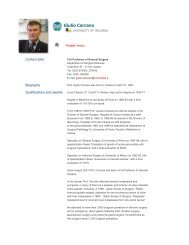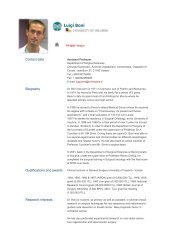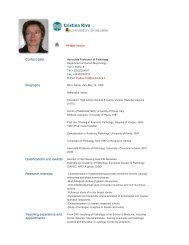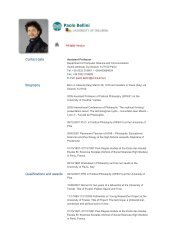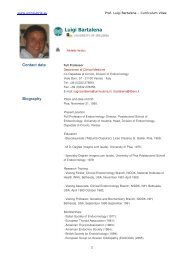Tiziana Rubino - The University of Insubria
Tiziana Rubino - The University of Insubria
Tiziana Rubino - The University of Insubria
Create successful ePaper yourself
Turn your PDF publications into a flip-book with our unique Google optimized e-Paper software.
<strong>Tiziana</strong> <strong>Rubino</strong><br />
Contact data<br />
Biography<br />
Qualifications and awards<br />
Research interests<br />
Assistant Pr<strong>of</strong>essor <strong>of</strong> Pharmacology<br />
Department <strong>of</strong> Structural and Functional Biology<br />
Via A. da Giussano 10, 21052 Busto Arsizio (VA)<br />
Tel: +39 0331 339416<br />
Fax: +39 0331 339459<br />
E-mail: tiziana.rubino@uninsubria.it<br />
Dr. <strong>Tiziana</strong> <strong>Rubino</strong> is an Assistant Pr<strong>of</strong>essor <strong>of</strong> Pharmacology at the<br />
<strong>University</strong> <strong>of</strong> <strong>Insubria</strong>. She received her degree in Biology in 1988 from<br />
the <strong>University</strong> <strong>of</strong> Milan with a thesis on opioid receptor alterations in<br />
morphine tolerance. In 1989 she was awarded the “Premio Gamba” for<br />
the best experimental thesis in the pharmacological field for the past<br />
year. In 1992 she was visiting scientist at the Immunology laboratory <strong>of</strong><br />
the “Istituto Scientifico dei Tumori” in Genoa, with a project on<br />
monoclonal antibodies production, and received her Ph.D. in Applied<br />
Biotechnology at the <strong>University</strong> <strong>of</strong> Milan. From 1995 to 1998 she<br />
received a fellowship from the Italian Ministry <strong>of</strong> Health on “Involvement<br />
<strong>of</strong> drug abuse in HIV progression”. From 1999 to 2002 she received a<br />
postdoctoral fellowship from the <strong>University</strong> <strong>of</strong> <strong>Insubria</strong> on “Neurobiology<br />
<strong>of</strong> cannabinoids: behavioral and biochemical evidences underlying<br />
tolerance and dependence”. From 2003 until the present she is<br />
researcher at the <strong>University</strong> <strong>of</strong> <strong>Insubria</strong>, School <strong>of</strong> Sciences. She is<br />
member <strong>of</strong> the Italian Society <strong>of</strong> Pharmacology and the International<br />
Cannabinoid Research Society.<br />
1988 Degree in Biological Sciences<br />
1989 She was awarded “Premio Gamba”<br />
1992 PhD in Applied Biotechnology<br />
Dr. <strong>Rubino</strong>’s career-long interest is represented by drugs <strong>of</strong> abuse. Her<br />
degree dissertation was about opioid receptor alterations in morphine<br />
tolerance. Since then her attention is focused on the molecular<br />
mechanisms underlying tolerance and dependence to different drugs <strong>of</strong><br />
abuse. At the beginning she studied opioid tolerance and showed that<br />
modifications in the amount <strong>of</strong> G proteins after chronic morphine<br />
treatment or the continuous infusion <strong>of</strong> selective opioid peptides<br />
represents part <strong>of</strong> the molecular underpinnings <strong>of</strong> opioid tolerance. A<br />
further change in G protein amounts that paralleled the behavioral<br />
manifestations <strong>of</strong> the abstinence syndrome was observed during opioid<br />
withdrawal strengthening the key role <strong>of</strong> G proteins in adaptation<br />
events following chronic treatment. She began working in the<br />
cannabinoid field in 1994 publishing on cannabinoid/opioid interaction<br />
at the CNS level. <strong>The</strong>n she focused her attention on the cellular effects<br />
in the CNS <strong>of</strong> in vivo chronic administration <strong>of</strong> natural and synthetic<br />
cannabinoids. Besides the demonstration <strong>of</strong> the occurrence <strong>of</strong>
ehavioral tolerance and physical dependence to natural, synthetic and<br />
endogenous cannabinoids, she focused her attention on the cellular<br />
mechanisms underlying these phenomena, showing the relevance in<br />
specific brain areas <strong>of</strong> the alterations in receptor number and efficiency,<br />
and in cyclic AMP cascade. Recently, with a double approach (genetic<br />
and pharmacological) she demonstrated the relevance <strong>of</strong> the Ras/ERK<br />
cascade in the molecular events occurring after chronic THC treatment.<br />
Finally, she focused her attention on a more clinically relevant topic,<br />
that is to clarify the possible role that the cannabinoid system plays in<br />
the neurobiology <strong>of</strong> anxiety, in order to have new insights for the<br />
potential therapeutic use <strong>of</strong> cannabinoid compounds in anxiety<br />
treatment.<br />
Teaching experience and<br />
appointments<br />
Representative<br />
publications<br />
Since 2001 she acts as a teacher for “Laboratory <strong>of</strong> Toxicology” for the<br />
undergraduate egree in Biology <strong>of</strong> Health.<br />
Since 2005 she acts as a co-teacher for “Pharmacogenomics” for the<br />
graduate degree in Biology<br />
She is a member <strong>of</strong> the Center <strong>of</strong> Neuroscience, <strong>University</strong> <strong>of</strong> <strong>Insubria</strong>,<br />
Busto Arsizio (VA)<br />
She is member <strong>of</strong> the internship committee for the undergraduate in<br />
Health Biology and the second level Degree in Biology Applied to<br />
Biomedical Research<br />
1. Vigano D, <strong>Rubino</strong> T, Parolaro D.<br />
Molecular and cellular basis <strong>of</strong> cannabinoid and opioid interactions.<br />
Pharmacol Biochem Behav. 2005, 81: 360-368<br />
2. <strong>Rubino</strong> T, Forlani G, Vigano D, Zippel R, Parolaro D.<br />
Ras/ERK signalling in cannabinoid tolerance: from behaviour to cellular<br />
aspects. J Neurochem. 2005 May;93(4):984-91.<br />
3. Vaccani A, Massi P, Colombo A, <strong>Rubino</strong> T, Parolaro D.<br />
Cannabidiol inhibits human glioma cell migration through a cannabinoid<br />
receptor-independent mechanism. Br J Pharmacol. 2005 Apr;144<br />
(8):1032-6.<br />
4. Vigano D, <strong>Rubino</strong> T., Vaccani A, Bianchessi S, Marmorato P,<br />
Castiglioni C, Parolaro D.<br />
Molecular mechanisms involved in the asymmetric interaction between<br />
cannabinoid and opioid systems. Neuropsychopharmacol. 2005 vol.<br />
182:527-536<br />
5. Vigano D, Valenti M, Cascio MG, Di Marzo V, Parolaro D, <strong>Rubino</strong> T.<br />
Changes in endocannabinoid levels in a rat model <strong>of</strong> behavioural<br />
sensitization to morphine. Eur J Neurosci. 2004 Oct;20(7):1849-57.<br />
6. Valenti M, Vigano D, Casico MG, <strong>Rubino</strong> T, Steardo L, Parolaro D,<br />
Di Marzo V.<br />
Differential diurnal variations <strong>of</strong> anandamide and 2-arachidonoylglycerol<br />
levels in rat brain. Cell Mol Life Sci. 2004 Apr;61(7-8):945-50<br />
7. <strong>Rubino</strong> T, Forlani G, Vigano D, Zippel R, Parolaro D.<br />
Modulation <strong>of</strong> extracellular signal-regulated kinases cascade by chronic<br />
delta 9-tetrahydrocannabinol treatment. Mol Cell Neurosci. 2004
Mar;25(3):355-62.<br />
8. <strong>Rubino</strong> T., Viganò D., Massi P. and Parolaro D.<br />
Cellular mechanisms <strong>of</strong> Delta 9-tetrahydrocannabinol behavioural<br />
sensatization”. Eur. J. Neurosci. 2003 17 (2), 325-330.<br />
9. Viganò D., Cascio M., <strong>Rubino</strong> T., Fezza F., Vaccani A., Di Marzo V.<br />
and Parolaro D.<br />
Chronic morphine modulates the contents <strong>of</strong> the cannabinoid, 2-<br />
arachidonoyl glycerol, in rat brain. Neuropsycopharmacol. 2003, 28 (6),<br />
1160-1167,.<br />
10. Viganò D., <strong>Rubino</strong> T., Di Chiara G., Ascari I., Massi P. and Parolaro<br />
D.<br />
Mu opioid receptor signaling in morphine sensitisation. Neuroscience,<br />
117 (4), 921-929, 2003.<br />
11. Massi P, Vaccani A, <strong>Rubino</strong> T, Parolaro D.<br />
Cannabinoids and opioids share cAMP pathway in rat splenocytes. J<br />
Neuroimmunol. 2003 Dec;145(1-2):46-54,.<br />
12. Parolaro D, <strong>Rubino</strong> T.<br />
Is cannabinoid transmission involved in rewarding properties <strong>of</strong> drugs<br />
<strong>of</strong> abuse? Br J Pharmacol. 2002, 136(8):1083-4.<br />
13. Parolaro D, Massi P, <strong>Rubino</strong> T, Monti E.<br />
Endocannabinoids in the immune system and cancer. Prostaglandins<br />
Leukot Essent Fatty Acids. 2002 Feb-Mar;66(2-3):319-32.<br />
14. Ponti W, <strong>Rubino</strong> T, Bardotti M, Poli G, Parolaro D.<br />
Cannabinoids inhibit nitric oxide production in bone marrow derived<br />
feline macrophages. Vet Immunol Immunopathol. 2001 Oct;82(3-<br />
4):203-14.<br />
15. <strong>Rubino</strong> T, Vigano D, Massi P, Parolaro D.<br />
<strong>The</strong> psychoactive ingredient <strong>of</strong> marijuana induces behavioural<br />
sensitization. Eur J Neurosci. 2001 Sep;14(5):884-6<br />
16. <strong>Rubino</strong> T, Vigano D, Costa B, Colleoni M, Parolaro D.<br />
Loss <strong>of</strong> cannabinoid-stimulated guanosine 5'-O-(3-[(35)S]<br />
Thiotriphosphate) binding without receptor down-regulation in brain<br />
regions <strong>of</strong> anandamide-tolerant rats. J Neurochem. 2000 Dec;75<br />
(6):2478-84.<br />
17. <strong>Rubino</strong> T, Vigano D, Massi P, Parolaro D.<br />
Changes in the cannabinoid receptor binding, G protein coupling, and<br />
cyclic AMP cascade in the CNS <strong>of</strong> rats tolerant to and dependent on<br />
the synthetic cannabinoid compound CP55,940. J Neurochem. 2000<br />
Nov;75(5):2080-6.<br />
18. <strong>Rubino</strong> T, Massi P, Vigano D, Fuzio D, Parolaro D.<br />
Long-term treatment with SR141716A, the CB1 receptor antagonist,<br />
influences morphine withdrawal syndrome. Life Sci. 2000 Apr 21;66
(22):2213-9.<br />
19. <strong>Rubino</strong> T, Vigano' D, Massi P, Spinello M, Zagato E, Giagnoni G,<br />
Parolaro D.<br />
Chronic delta-9-tetrahydrocannabinol treatment increases cAMP levels<br />
and cAMP-dependent protein kinase activity in some rat brain regions.<br />
Neuropharmacology. 2000 Apr 27;39(7):1331-6.<br />
20. <strong>Rubino</strong> T, Vigano D, Zagato E, Sala M, Parolaro D.<br />
In vivo characterization <strong>of</strong> the specific cannabinoid receptor antagonist,<br />
SR141716A: behavioral and cellular responses after acute and chronic<br />
treatments. Synapse. 2000 Jan;35(1):8-14.<br />
21. Bianchi M, Maggi R, Pimpinelli F, <strong>Rubino</strong> T, Parolaro D, Poli V,<br />
Ciliberto G, Panerai AE, Sacerdote P.<br />
Presence <strong>of</strong> a reduced opioid response in interleukin-6 knock out mice.<br />
Eur J Neurosci. 1999 May;11(5):1501-7.<br />
22. Massi P, Sacerdote P, Ponti W, Fuzio D, Manfredi B, Vigano D,<br />
<strong>Rubino</strong> T, Bardotti M, Parolaro D.<br />
Immune function alterations in mice tolerant to delta9-<br />
tetrahydrocannabinol: functional and biochemical parameters. J<br />
Neuroimmunol. 1998 Dec 1;92(1-2):60-6.<br />
23. Garcia-Gil L, Ramos JA, <strong>Rubino</strong> T, Parolaro D, Fernandez-Ruiz JJ.<br />
Perinatal delta9-tetrahydrocannabinol exposure did not alter dopamine<br />
transporter and tyrosine hydroxylase mRNA levels in midbrain<br />
dopaminergic neurons <strong>of</strong> adult male and female rats. Neurotoxicol<br />
Teratol. 1998 Sep-Oct;20(5):549-53.<br />
24. <strong>Rubino</strong> T, Patrini G, Massi P, Fuzio D, Vigano D, Giagnoni G,<br />
Parolaro D.<br />
Cannabinoid-precipitated withdrawal: a time-course study <strong>of</strong> the<br />
behavioral aspect and its correlation with cannabinoid receptors and G<br />
protein expression. J Pharmacol Exp <strong>The</strong>r. 1998 May;285(2):813-9.<br />
25. <strong>Rubino</strong> T, Tizzoni L, Vigano D, Massi P, Parolaro D.<br />
Modulation <strong>of</strong> rat brain cannabinoid receptors after chronic morphine<br />
treatment. Neuroreport. 1997 Oct 20;8(15):3219-23.<br />
26. Massi P, Patrini G, <strong>Rubino</strong> T, Fuzio D, Parolaro D.<br />
Changes in rat spleen cannabinoid receptors after chronic CP-55,940:<br />
an autoradiographic study. Pharmacol Biochem Behav. 1997 Sep;58<br />
(1):73-8.<br />
27. <strong>Rubino</strong> T, Patrini G, Parenti M, Massi P, Parolaro D.<br />
Chronic treatment with a synthetic cannabinoid CP-55,940 alters G-<br />
protein expression in the rat central nervous system. Brain Res Mol<br />
Brain Res. 1997 Mar;44(2):191-7.<br />
28. <strong>Rubino</strong> T, Parenti M, Patrini G, Massi P, Parolaro D.<br />
Morphine withdrawal syndrome and G protein expression: a study <strong>of</strong><br />
the time course in the rat central nervous system. Eur J Neurosci. 1995
Nov 1;7(11):2334-40.<br />
29. <strong>Rubino</strong> T, Massi P, Patrini G, Venier I, Giagnoni G, Parolaro D.<br />
Chronic CP-55,940 alters cannabinoid receptor mRNA in the rat brain:<br />
an in situ hybridization study. Neuroreport. 1994 Dec 20;5(18):2493-6.<br />
30. <strong>Rubino</strong> T, Massi P, Patrini G, Venier I, Giagnoni G, Parolaro D.<br />
Effect <strong>of</strong> chronic exposure to naltrexone and opioid selective agonists<br />
on G protein mRNA levels in the rat nervous system. Brain Res Mol<br />
Brain Res. 1994 Jun;23(4):333-7.<br />
Clinical interests<br />
<strong>The</strong> potential clinical relevance <strong>of</strong> the completed research lies in<br />
possible applications for the therapy <strong>of</strong> drug dependence and <strong>of</strong> some<br />
psychiatric disorders such as anxiety


